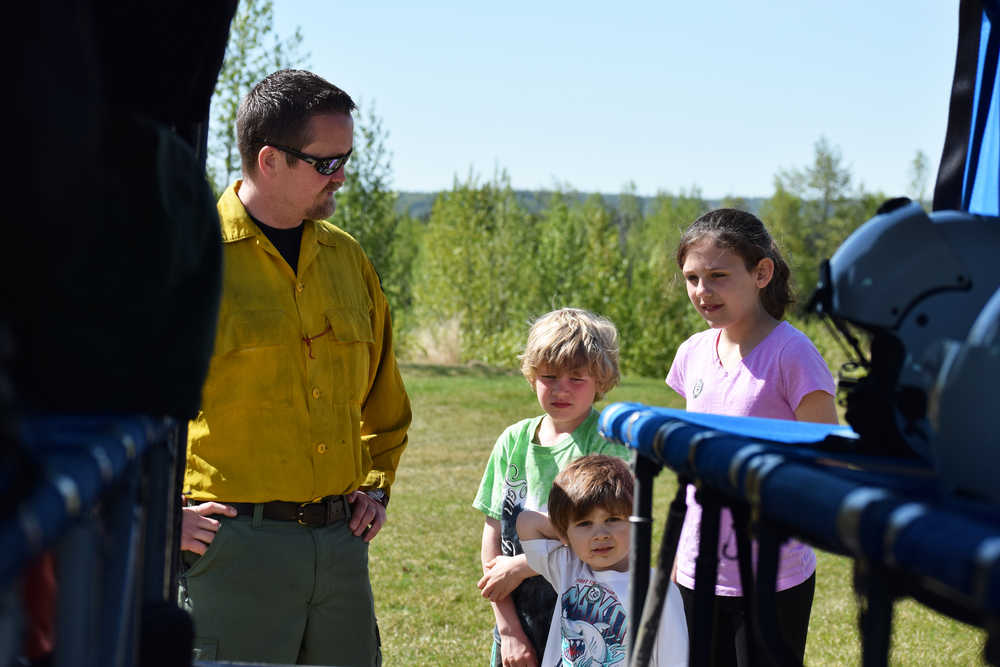Curious residents young and old turned out to get their questions answered — and a free tree — at the Alaska Division of Forestry’s open house Saturday.
Hosted at the Kenai-Kodiak Area Office in Soldotna, the open house served as a place to get information and get to know the division’s firefighting staff a bit better as the Kenai Peninsula heads into a hot early fire season.
Held to coincide slightly with National Wildfire Community Preparedness Day on May 7, the open house also featured $500 worth of fire-resistant species of trees including tamaracks, blue spruce and Siberian Larch that visitors could take with them.
The National Fire Protection Association and State Farm Insurance offered $500 wildland grants for the occasion, one of which Dan Govoni, the division’s fire prevention officer for Soldotna, used to get the trees.
Much of the open house was spent providing residents with information about wildland fires and the Fire Wise and Ready-Set-Go programs.
One of the biggest misconceptions people living in more urban areas have, Govoni said, is that because they are not closely surrounded by wilderness, they don’t have to worry about preparing for a wildfire.
“As we’ve seen down on the Kenai and they saw recently in Canada, once these wildfires get going they have a pretty long reach,” he said. “So it’s just getting people to recognize, you know, clean up the debris in your yard, keep your lawns maintained, trim your trees back. With the Ready-Set-Go Program, it’s having an evacuation plan in place. What are you going to do? Who are you going to contact? Do you know where your evacuation areas are?”
Conditions like wind and finer fuels like grass fields make the Alaska even more vulnerable to powerful wildland fires, said contract pilot Ken Carlton, who flew firefighters in a Bell helicopter during both the Funny River and Card Street fires.
“What was amazing to me is how fast the fires — how fast they get big here,” he said. “You don’t see that down in the Lower 48.”
The peninsula’s pervasive black spruce population is another aggravator when it comes to wildfires, Carlton said.
“From the air it … looked like somebody set off a dynamite charge,” he said of watching black spruce catch fire. “They just explode.”
The trees handed out at the open house were in part to curb the effects of black spruce when it comes to fires, Govoni said. He chose them to promote rehabilitation of areas burnt by the last two wild fires.
“I based it on the fact that we’d had Card Street and Funny River, and we’d had a number of people and properties in the area impacted by the fires,” Govoni said of the event.
The day also helped residents put faces to the men and women they rely on when fires strike in their back yard.
“We brought our engine out and we have our firefighting helicopter here, just so the people can get up close and actually see … some of the resources here, and then actually get to meet the crews, too.” Govoni said. “You know, they see us driving around, they’ll see pictures (of us) on fires, or they’ll see us running through their neighborhoods, but they’ve never gotten to get up close and say, ‘Hi, I’m so and so and thank you for this.’”
One thankful resident who turned out to collect a tree was Barbara Sokolov, who lives in the Kenai Keys subdivision in Sterling and has evacuated during the last two fire seasons. During the Card Street fire, one of her neighbors sat in his boat and watched as a wall of flames drew closer and closer to the Kenai River, she said.
“We left as soon as we realized that the road was in danger,” Sokolov said, explaining that she and her husband have a place to stay in Anchorage.
When it looked like the fire wouldn’t be stopped before it hit the subdivision, she said the neighbor called another subdivision resident who was also in Anchorage and said, “The Keys are gone.”
“And we went to bed that night thinking, ‘well, we were trying to downsize’ and this is going to do it,” Sokolov said.
Luckily, few houses were devoured by the Card Street fire and Sokolov returned safety home.
With all the fuels in the Kenai Keys area that were left burnt by last year’s fire, Sokolov said she’s hopeful they will avoid another evacuation this summer.
“That’s what the saying there is. ‘We’re out of the woods, there aren’t any left,’” she said.

